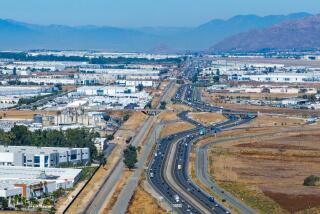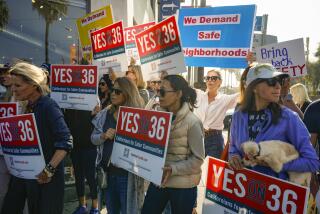Senate OKs Bill for Development of ‘Doughnut Hole’ : Land use: The 1,000-acre parcel could no longer be annexed by Redlands, which has opposed projects.
- Share via
SACRAMENTO — Inside the Capitol, state legislators are getting a bellyful of a “doughnut hole.”
This “doughnut hole” is not a pastry but about 1,000 acres of aging orange groves and mostly vacant land--surrounded by the city of Redlands--that its owners see as prime commercial land.
In the final days of the 1999 legislative session, this San Bernardino County real estate has become the target of an intense lobbying campaign as legislators scramble to wrap up their work.
It’s not unusual for legislation to be advanced to benefit particular economic interests. In recent weeks, measures have been brought up to allow higher rental car rates at San Jose Airport, establish a new ferry service on San Francisco Bay and direct state agencies to buy only recyclable printer cartridges.
But the fight over the orange grove in some ways stands out as a replay of the way developers attempted to resolve local growth squabbles in the 1970s and early 1980s by appealing to state legislators to settle the issue.
In this instance, 64 owners of the land, including a firm co-owned by Los Angeles developer Ed Roski Jr., have persuaded a Montebello legislator to sponsor legislation that effectively would strip Redlands of authority over the “doughnut hole.”
At issue is to what extent the 120 members of the Legislature should serve as a super-planning agency for a hotly contested piece of property, and whether a precedent would be set that would make it easier for builders in Santa Monica or Fresno to appeal to the Legislature.
Supporters say the bill, AB 1553, by Democratic Assemblyman Thomas Calderon passes what is known around the Capitol as “the smell test,” meaning that they are not seeking to be exempted from building controls nor trying to disrupt an environmentally sensitive area.
Instead, they want to be allowed to switch oversight of the property, which is close to the freeway, to San Bernardino County in hopes that county officials will approve the Citrus Plaza shopping center and other growth. The center is planned by a partnership that includes Roski’s Majestic Realty Co., a major Southern California development firm.
Calderon’s proposal is backed by the property owners, who fear that Redlands will squelch development, and by San Bernardino County supervisors but opposed by Redlands and the League of California Cities. On Tuesday, the state Senate passed the measure 22 to 9 and sent it to the Assembly.
“If the Legislature injects itself into Redlands’ land use politics,” said a consultant for the Senate Local Government Committee, “how will the committee react when the next bill presents itself? What’s the next project after Citrus Plaza?”
Both sides agree that the Calderon bill is focused only on acreage near the intersection of Interstate 10 and California 30 and not far from the closed Norton Air Force Base.
It’s one of the few things they do agree upon.
Over the past 25 years, the property has been in Redlands’ “sphere of influence,” meaning it was likely that the city in what was once the heart of citrus groves would close to the freeway eventually annex the land to become part of Redlands.
According to a Senate committee analysis of the situation, a bitter dispute has erupted over the timing and the way development should occur around the “doughnut hole,” prompting lawsuits, land use initiatives and deep divisions.
The legislation would allow the property owners to petition San Bernardino to put the land under its “sphere of influence” umbrella. A separate measure, AB 1555, by Assemblyman John Longville (D-Rialto) would make it easier for cities to annex land but specifically exempts the “doughnut hole.”
The Citrus Plaza shopping center, which would be on about 100 acres of the land, is seen by the bill’s backers as the linchpin of development that would bring a bonanza of jobs to the entire area.
“It’s unusual for the state to intervene on a local issue,” said Richard Kunihira, who is president of the United Doughnut Hole Owners Property Assn. and whose family has owned orange groves on the land for two decades. “I think it’s not just a local issue, but it’s a regional issue . . . essential for the economic revitalization of the county seat, San Bernardino.”
To opponents, the bill is a throwback to tightly drawn special interest developer bills that in previous decades were advanced routinely in the Legislature to address building restrictions imposed by cities.
“It’s focused only on the doughnut hole and Redlands,” said Redlands Mayor Bill Cunningham, who opposes the measure as one designed to benefit only property owners, including Roski, who has been trying to bring an NFL football team back to Los Angeles.
“This legislation is about Majestic getting exactly what it wants no matter what it has to say or spend to do it,” said Cunningham, who faces reelection later this year. He said the city has spent more than $5 million on public works, including water and sewers, for the “doughnut hole.”
Cunningham, 72, who came to Redlands as a young teacher nearly half a century ago, says he is willing to sit down with the property owners. Pleading his case in Sacramento, Cunningham said, “a horde of lobbyists would follow us with distortions and claims that the city had no investment in the doughnut hole.”
Opponents characterize Cunningham as an anti-growth zealot and see him as their chief roadblock.
Calderon denied that his legislation is a special deal. The first-term legislator said his project provides a way to ensure that the property owners, including Majestic Realty and its shopping center partner, can sell or develop their property as they wish without interference from Redlands.
“We’re not asking to build on historical Indian burial grounds or an environmentally sensitive land,” said Tim Chaikovsky, Majestic’s vice president of business affairs. “This area has been zoned industrial and commercial for 10 years.
“The legislation is intended to allow water and sewer [service] to be provided to this area without continual attacks from Redlands,” he said.
More to Read
Sign up for Essential California
The most important California stories and recommendations in your inbox every morning.
You may occasionally receive promotional content from the Los Angeles Times.










